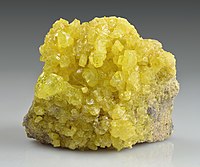
Photo from wikipedia
Abstract In order to intrinsically boost the photocatalytic performance of WO3/CdS, the charge transfer route can be modulated from conventional type-Ⅱ to Z-scheme by incorporating of hydrogen ions into WO3/CdS… Click to show full abstract
Abstract In order to intrinsically boost the photocatalytic performance of WO3/CdS, the charge transfer route can be modulated from conventional type-Ⅱ to Z-scheme by incorporating of hydrogen ions into WO3/CdS to form H0.53WO3/CdS. This work indicates that only when charge transfer of WO3/CdS is type-Ⅱ, can H0.53WO3/CdS composite be formed in-situ. Subsequently, the Z-scheme photocatalytic mechanism plays its prominent roles in gradually improving photocatalytic H2 evolution performance. H0.53WO3/CdS has high photocatalytic activity for hydrogen production, which is much higher than that of WO3/CdS. This work will provides an in-depth understanding of charge separation and transfer processes and steer charge flow in a Z-scheme manner for efficient solar-to-chemical energy applications.
Journal Title: Applied Catalysis B: Environmental
Year Published: 2019
Link to full text (if available)
Share on Social Media: Sign Up to like & get
recommendations!